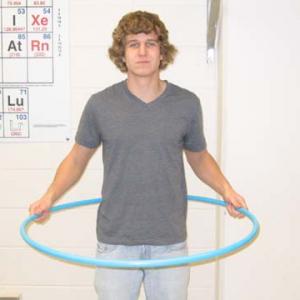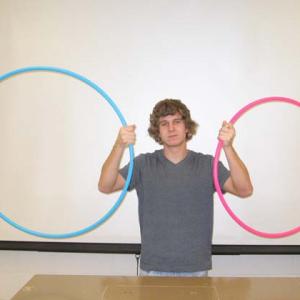College of Liberal Arts & Sciences
3A95.63 - Hula Hoop
The Hula Hoop can be used for a variety of demonstrations.
Friction: It is the friction between your clothes and the hoop that keep it spinning.
Resonance: Your hips need so swing at the right frequency to keep the hoop spinning.
Moment of Inertia: Add identical masses to two opposite places inside the hoop. You will find it much easier to swing with your hips. Also, hold the hoop vertically with the weights at the top and bottom ( one weight under your hand and the other at the bottom of the hoop near the floor). You will find that in this configuration the hoop is easy to twist about a vertical axis. Now change the orientation so that the weights are at the 3 and 9 o'clock positions. Twisting the hoop about a vertical axis again should reveal that the hoop twists much more slowly.
- Alexander P. Seyranian, Anton O. Belyakov, "How to Twirl a Hula Hoop", AJP, Vol. 79, # 7, July 2011, p. 712.
- 50 Fun Experiments for the Mad Scientist in You, "Hula-Hoop Observation", National Geographic Kids, p. 42.
- H. Richard Crane, "Chattering, The Chatterring, and the Hula Hoop", How Thing Work ( 1983 - 1995 ), p. 117.
- Jearl Walker, "1.84, Spinning Hula Hoops and Lassos", The Flying Circus of Physics Ed. 2, p. 43.
- Ed Sobey, Woody Sobey, "Hula Hoop", The Way Toys Work, p. 68.
Disclaimer: These demonstrations are provided only for illustrative use by persons affiliated with The University of Iowa and only under the direction of a trained instructor or physicist. The University of Iowa is not responsible for demonstrations performed by those using their own equipment or who choose to use this reference material for their own purpose. The demonstrations included here are within the public domain and can be found in materials contained in libraries, bookstores, and through electronic sources. Performing all or any portion of any of these demonstrations, with or without revisions not depicted here entails inherent risks. These risks include, without limitation, bodily injury (and possibly death), including risks to health that may be temporary or permanent and that may exacerbate a pre-existing medical condition; and property loss or damage. Anyone performing any part of these demonstrations, even with revisions, knowingly and voluntarily assumes all risks associated with them.

